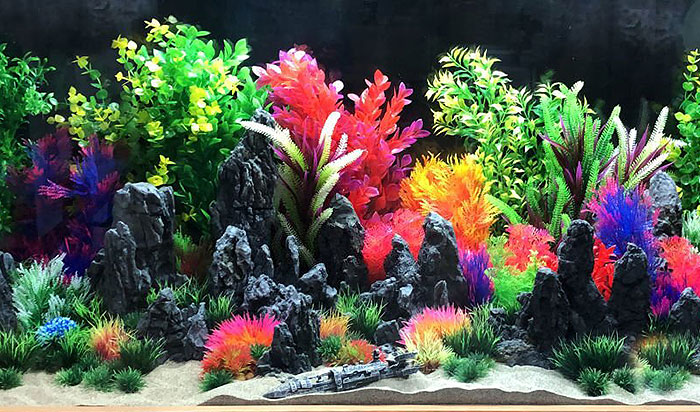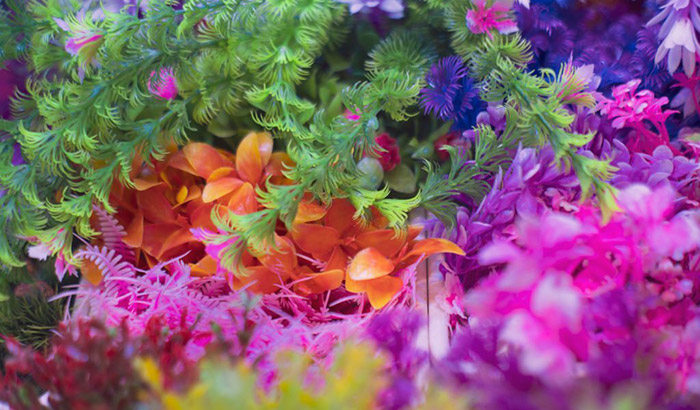New homes are always clean and pristine, but this changes over time.
The same can be said for tanks or aquariums as their appearance and environment change once it’s been lived in. Much like any home, you must clean the tank’s contents, removing and scrubbing them so everyone residing in it will be comfortable and healthy.
Cleaning tanks, however, is not as straightforward as it seems. Plastic aquarium plants, for example, can be quite difficult to restore to their former state. It’s important to know how to clean plastic aquarium plants properly to ensure they don’t get damaged while cleaning.
Contents
The Challenges of Cleaning Plastic Aquarium Plants
Although plastic aquarium plants may be easier to clean than live ones, cleaning them can still be a hassle.
This is because using too much force while brushing can damage artificial plants. Plus, using harsh chemicals can cause health problems for your aquarium fish and other tank dwellers. Dirt particles may also continue to cling to the plastic plants even after they’ve been washed.
How to Clean Artificial Plants in Aquarium
Cleaning aquariums regularly will go a long way in preventing moss and debris build-up. Here’s how you can do it.
What You’ll Need
It won’t take much special equipment or fancy supplies to clean your plastic tank plants. You can easily find everything you need in your home. Here’s what you’ll need to prepare.
- Clean water
- Kettle or water heater
- Container
- Scrubber
- Vinegar or bleach
- Spray bottle
Step 1: Take Out The Plants
Taking out the plants from the aquarium is the first step. Do this when you’re changing the water of the tank and after you have removed the fish. Carefully pull out the plastic plants to avoid stirring up debris.
You don’t need any special equipment to do this. You can use your bare hands or a net to remove the plastic plants from the aquarium.
Step 2: Wash, Soak, and Scrub
Wash the plastic aquarium plants with running water. Using warm water is ideal as it can help sanitize and loosen debris tucked into them.
You can expect some algae on the plastic plants. Algae may be more difficult to clean than other dirt or buildup but you can easily remove them.
There are three options on how to clean algae off plastic aquarium plants during the wash and soak step.
Using boiling water
You can use boiling water to wash the plastic. After all, it is much easier to kill algae contamination with boiling water. Plus, boiling water limits the possibility of exposing your tank dwellers to chemicals.
Here’s how you can wash and soak using boiling water
- Place the newly boiled clean water in a clean container
- Place the plastic plants in the container with boiling water
- Leave for ten to fifteen minutes
- Using your scrubber, remove all algae on the plants
- Take out the plants from the container with water
- Wash them with running water
- Air dry the plastic plants
Using bleach mixture
You will need a bleach mixture when you are dealing with heavily contaminated plastic plants with algae. Boiling water alone sometimes won’t remove the algae.
Here is how to clean plastic plants using a bleach solution.
- Mix one part of bleach with nine amounts of water in a container. Do not use a metal container as it will react to the bleach.
- Place the plastic plants into the mixture
- Leave for at least 15 minutes
- Scrub the plants using the scrubber
- Soak the plants again in the bleach mixture for at least another 15 minutes
- Remove the plants from the bleach solution
- Rinse the plants with running water for a couple of minutes
- Make sure that every part of the plant has been washed off with clean water
Using bleach mixture
The vinegar mixture is great for removing the calcium residue build-up. Instead of spending hours scrubbing the plastic aquarium plants, soaking them in a vinegar mixture will save you hours of
- Mix half a cup of vinegar and half a gallon of sterilized water in a container
- Mix them well
- Pour the vinegar mixture into a spray bottle
- Spray the mixture on the plastic plants, making sure each area has been sprayed with the solution
- Scrub the plants using the scrubber
- Wash the plants in running water
- You can air dry the plants before putting them back in the aquarium
Step 3: Drying the Plants
Drying the plants is necessary to avoid introducing any water to the aquarium that has not yet been acclimated to the tank’s environment.
Plastic plants that still have water on them can cause an imbalance in the environmental structure of the tanks. Simply air dry the plastic plants for a couple of hours until all the moisture is gone.
Step 4: Putting Back the plants
Simply put back the plants in the aquarium. Be careful when you place them back so you won’t mess up the order of the other decorations or items inside the tank.
How to Clean Plastic Plants Before Putting in Aquarium When They’re New
Cleaning brand-new plastic aquarium plants are much easier than cleaning those that have been used in a tank.
While brand new plastic plants are not contaminated with algae and other buildup from the aquarium they can still be contained with particles or dust.
You don’t need to sterilize them. Simply wash them in cold running water before putting them in a container filled with cold water for soaking.
Leave the plants soaked for at least five minutes and wash them again with running water. Make sure to air dry the plastic aquarium plants before putting them inside the tank.
In a Nutshell
Cleaning plastic aquarium plants is not that complicated. However, you must be careful in cleaning them by simply following the above steps on how to clean aquarium plants.
Otherwise, you may not be able to remove all the contamination and build-up found on the plant. You can also expose your tank dwellers to harmful elements and put them in danger if you fail to wash and dry the plastic plants properly.


